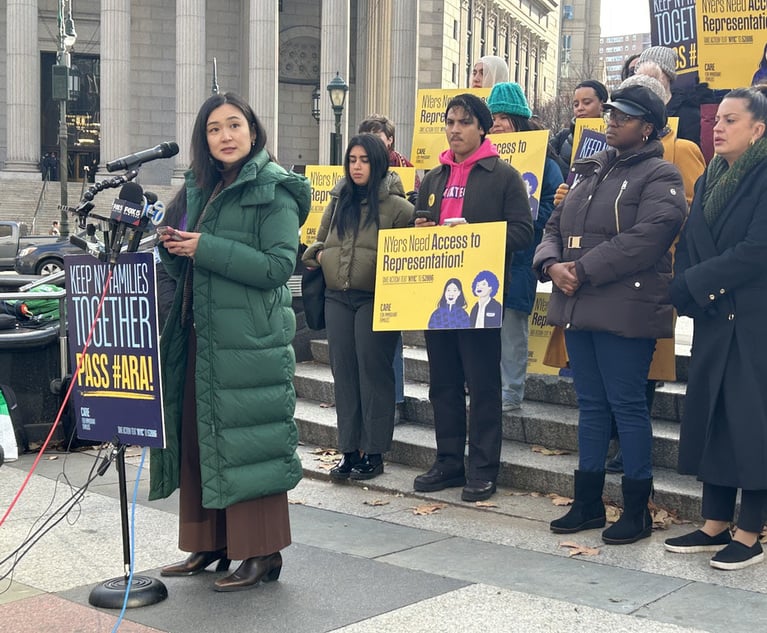Apple Sales Tax Case Disregards Form of Transaction
In their Tax Appeals Tribunal column, Joseph Lipari and Aaron Gaynor discuss the recent case of 'Apple Inc.', DTA No. 827287 (N.Y. Div. Tax App., Nov. 20, 2018), in which the lesson for taxpayers is to act consistently. That may matter more than the form or the substance of the transaction.
March 07, 2019 at 02:45 PM
7 minute read

In the September 2018 edition of this column, we discussed the case of CLM Associates, LLC, DTA No. 826735 (N.Y. Tax App. Trib., Feb. 12, 2018), in which the Tax Appeals Tribunal held that a series of transactions among affiliated companies were subject to sales tax. See Joseph Lipari and Aaron S. Gaynor, “Recent Case Demonstrates Risk of Sales Tax in Affiliate Transactions,” NYLJ (Sept. 6, 2018). In CLM, the Tribunal disregarded that the companies engaging in the transactions comprised a single business enterprise, and looked to the formalistic nature of property transferring between separate entities for consideration. However, in the recent case of Apple Inc., DTA No. 827287 (N.Y. Div. Tax App., Nov. 20, 2018), the Division of Tax Appeals instead of disregarding the substance of a set of transactions, disregarded the form of the transaction to find that the popular customer electronics producer and retailer had under-collected sales tax in connection with a promotional program.
|The Law
N.Y. Tax Law §1105(a) generally imposes tax on the sale of the “retail sale of tangible personal property.” Subdivision (a) of 20 N.Y.C.R.R. §526.5 generally defines “receipt” (the sales tax base) as “the sale price of any property.” However, subdivision (c)(3) of that regulation provides that, where a seller charges an unreimbursed discounted price, “the tax is due from the purchaser on only the discounted price” (emphasis added). Thus, if property normally sold for $100 is on sale for $80, sales tax is collected only on the lower $80 price. New York Sales Tax Bulletin No. TB-ST-806 (April 13, 2011) provides that the sale of gift cards is exempt from sales tax, recognizing that sales tax will be paid upon the redemption of the gift card (to the extent that the purchased items are subject to sales tax).
|Back-to-School Promotion
In 2011 and 2012, Apple, known for its iPhones, iPads, and personal computers, ran a back-to-school promotion, under which qualifying customers would receive a gift card upon the purchase of certain devices. The gift cards were redeemable at Apple's online stores in exchange for digital content including software, music, movies, games, and books.
With respect to devices purchased through its online store, Apple collected sales tax on the “sticker price” (for the sake of illustration, $1,000), and then separately issued a gift card (for illustration, $100) to the customer at no additional charge. However, due to limitations with the point of sale (POS) system in its physical retail stores, Apple was unable to dispense the gift cards at no additional charge. Therefore, in order to accommodate the promotion, Apple discounted the device by the amount of the gift card. For example, rather than charging $1,000 for a device and giving the customer a $100 gift card at no additional cost, Apple reduced the cost of the device by $100 (to $900) and charged the customer $100 for the gift card. In these cases, Apple collected sales tax only on $900 (the discounted price of the device), as gift cards are not subject to sales tax
|Apple's Arguments
Apple argued that the gift card was not “free,” and, implicitly, that Apple received consideration for the gift card, but gave the customer an offsetting discount against the sales-taxable device. The record, however, was somewhat mixed on this point.
Although Apple's marketing materials were careful not to use the word “free,” one advertisement notes that customers “will not be charged for the gift card.” Additionally, the terms and conditions of the program stated that customers purchasing a qualifying device “may receive” a gift card (again, without mention of the gift card expressly being free).
However, an FAQ on Apple's website states, with respect to the promotion, that a customer's “invoice or receipt will [] show an equivalent discount amount to cancel out the charge for the card,” rather than showing the gift card as purchased for no consideration. Moreover, in the event that a customer declined the gift card, that customer paid the full sticker price for the device, and Apple collected sales tax based upon that amount. Further, if a customer returned the device, the customer was required to return the gift card as well in order to receive a complete refund. (In such a case, the customer did not receive a refund to the extent that the customer already used the gift card.)
Apple argued that the imposition of the sales tax on the gift card (or on the discounted portion of device) would cause a double sales tax, because when the customer redeemed the gift card for sales-taxable items, sales tax would also be paid at that time.
|The Determination
The ALJ held against Apple, ruling that sales tax was due and collectible on the full amount paid for the purchased device without any reduction for the value of the gift card on the theory that the gift card was provided for free. Although the ALJ acknowledged the absence of the word “free” from the relevant materials, he stated that “the implication [from the terms and conditions] is clear that the gift card was free.” The ALJ went on that, rather than looking to the form, “the offer must be interpreted as an average customer would view the offer.” Finally, the ALJ notes that Apple's ultimate undoing was the inconsistency between the form of the transaction with respect to online sales (for which sales tax was collected on the full sticker price) and the form with respect to in-store sales (for which sales tax was collected only on the discounted price). As to Apple's argument that there would be double sales tax once the gift card was redeemed, the ALJ dismissed the issue, stating that the purchase and redemption of the gift card should be viewed as separate transactions (rather than one).
|What Went Wrong
Apple did itself no favors by using a different form of transaction for online and in-store sales. As an additional matter, the record reflects that the form of transaction for in-store sales was determined based on the limitations of the POS system, rather than an effort to more properly reflect the economic arrangements. Nevertheless, it is not clear that the ALJ came to the right conclusion.
The transaction in which customers engaged in store was to receive a dollar-for-dollar discount on a (sales-taxable) device for the purchase of a (non–sales-taxable) gift card. As a general matter, sales tax is due only upon a discounted price (and not the “gross” price before the application of a discount). While the ALJ may have been correct that customers viewed the arrangement as a “free” gift card (rather than a discount on a device), he did not properly apply the law to the transaction. If the ALJ was focused on substance and consistency rather than form, Apple should have argued that they over-collected sales on tax online sales, and that the in-store sales tax collection was correct. The bottom line is that under the ALJ determination, once the gift cards are used, sales tax will be charged and collected on an amount of sales greater than actually realized.
What makes the determination alarming, however, is that the state seems to being pressing a “heads I win, tails you lose” position on sales tax. That is, when it suits them, such as in CLM, the state will ignore the economic reality of a transaction, and hold a hard line on a formalistic application of the sales tax rules. However, when the state is displeased with the results of formalism, as they were with Apple, they will pursue a substance-over-form approach to a controversy.
The lesson for taxpayers here may be to act consistently. That may matter more than the form or the substance of the transaction.
Joseph Lipari is a partner and Aaron S. Gaynor is an associate at the law firm of Roberts & Holland.
This content has been archived. It is available through our partners, LexisNexis® and Bloomberg Law.
To view this content, please continue to their sites.
Not a Lexis Subscriber?
Subscribe Now
Not a Bloomberg Law Subscriber?
Subscribe Now
NOT FOR REPRINT
© 2025 ALM Global, LLC, All Rights Reserved. Request academic re-use from www.copyright.com. All other uses, submit a request to [email protected]. For more information visit Asset & Logo Licensing.
You Might Like
View All
So Who Won? Congestion Pricing Ruling Leaves Both Sides Claiming Victory, Attorneys Seeking Clarification
4 minute read
Hochul Vetoes 'Grieving Families' Bill, Faulting a Lack of Changes to Suit Her Concerns

Court System Names New Administrative Judges for New York City Courts in Leadership Shakeup
3 minute read
Trending Stories
- 1How to Litigate Before the EU’s Top Court, the European Court of Justice
- 2After Solving Problems for Presidents, Ron Klain Now Applying Legal Prowess to Helping Airbnb Overturn NYC Ban
- 3Attorneys Allege Contract Broken for Sharing $13M in Fees From MDL
- 4ZwillGen Acquires Lawyers, Scientists and Technology from Luminos.Law, Developer of Luminos.AI Platform
- 5Clifford Chance Strengthens Private Credit Offering With Mayer Brown Partners
Who Got The Work
Michael G. Bongiorno, Andrew Scott Dulberg and Elizabeth E. Driscoll from Wilmer Cutler Pickering Hale and Dorr have stepped in to represent Symbotic Inc., an A.I.-enabled technology platform that focuses on increasing supply chain efficiency, and other defendants in a pending shareholder derivative lawsuit. The case, filed Oct. 2 in Massachusetts District Court by the Brown Law Firm on behalf of Stephen Austen, accuses certain officers and directors of misleading investors in regard to Symbotic's potential for margin growth by failing to disclose that the company was not equipped to timely deploy its systems or manage expenses through project delays. The case, assigned to U.S. District Judge Nathaniel M. Gorton, is 1:24-cv-12522, Austen v. Cohen et al.
Who Got The Work
Edmund Polubinski and Marie Killmond of Davis Polk & Wardwell have entered appearances for data platform software development company MongoDB and other defendants in a pending shareholder derivative lawsuit. The action, filed Oct. 7 in New York Southern District Court by the Brown Law Firm, accuses the company's directors and/or officers of falsely expressing confidence in the company’s restructuring of its sales incentive plan and downplaying the severity of decreases in its upfront commitments. The case is 1:24-cv-07594, Roy v. Ittycheria et al.
Who Got The Work
Amy O. Bruchs and Kurt F. Ellison of Michael Best & Friedrich have entered appearances for Epic Systems Corp. in a pending employment discrimination lawsuit. The suit was filed Sept. 7 in Wisconsin Western District Court by Levine Eisberner LLC and Siri & Glimstad on behalf of a project manager who claims that he was wrongfully terminated after applying for a religious exemption to the defendant's COVID-19 vaccine mandate. The case, assigned to U.S. Magistrate Judge Anita Marie Boor, is 3:24-cv-00630, Secker, Nathan v. Epic Systems Corporation.
Who Got The Work
David X. Sullivan, Thomas J. Finn and Gregory A. Hall from McCarter & English have entered appearances for Sunrun Installation Services in a pending civil rights lawsuit. The complaint was filed Sept. 4 in Connecticut District Court by attorney Robert M. Berke on behalf of former employee George Edward Steins, who was arrested and charged with employing an unregistered home improvement salesperson. The complaint alleges that had Sunrun informed the Connecticut Department of Consumer Protection that the plaintiff's employment had ended in 2017 and that he no longer held Sunrun's home improvement contractor license, he would not have been hit with charges, which were dismissed in May 2024. The case, assigned to U.S. District Judge Jeffrey A. Meyer, is 3:24-cv-01423, Steins v. Sunrun, Inc. et al.
Who Got The Work
Greenberg Traurig shareholder Joshua L. Raskin has entered an appearance for boohoo.com UK Ltd. in a pending patent infringement lawsuit. The suit, filed Sept. 3 in Texas Eastern District Court by Rozier Hardt McDonough on behalf of Alto Dynamics, asserts five patents related to an online shopping platform. The case, assigned to U.S. District Judge Rodney Gilstrap, is 2:24-cv-00719, Alto Dynamics, LLC v. boohoo.com UK Limited.
Featured Firms
Law Offices of Gary Martin Hays & Associates, P.C.
(470) 294-1674
Law Offices of Mark E. Salomone
(857) 444-6468
Smith & Hassler
(713) 739-1250






